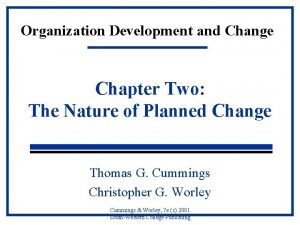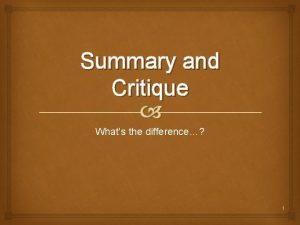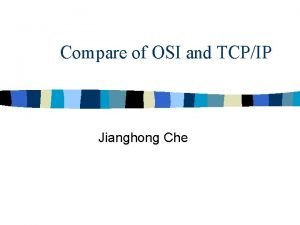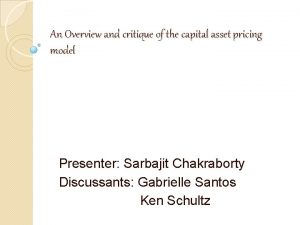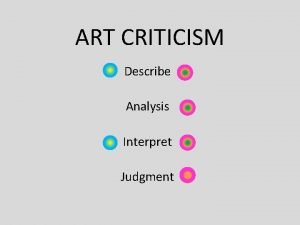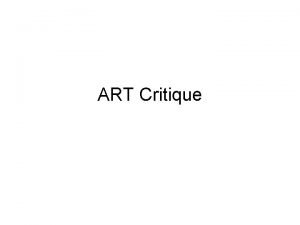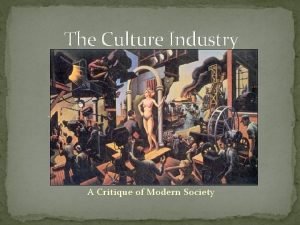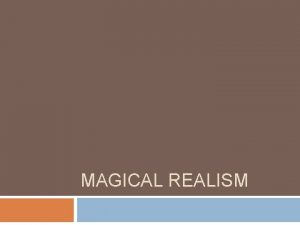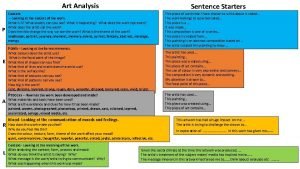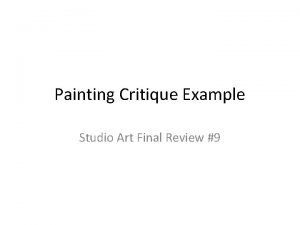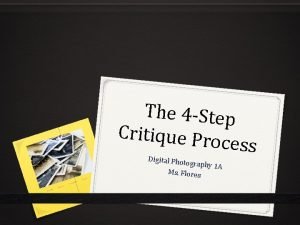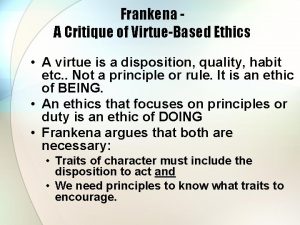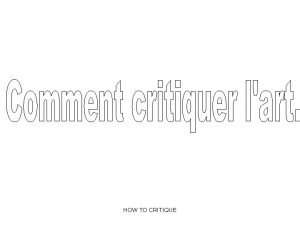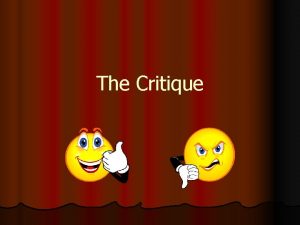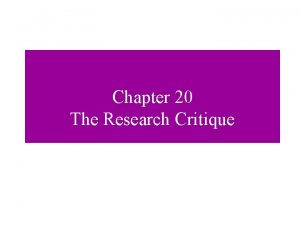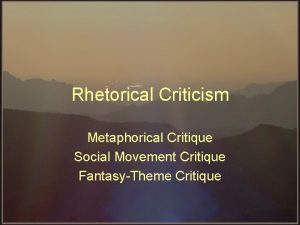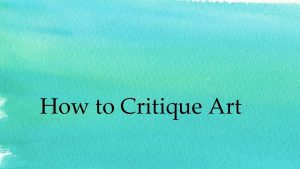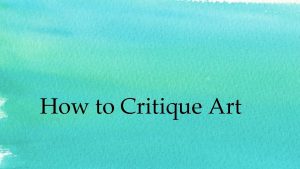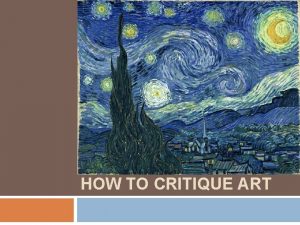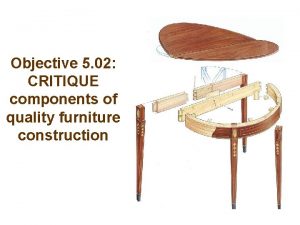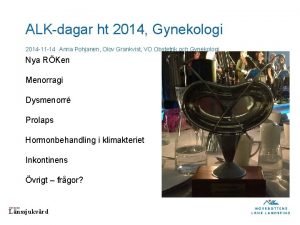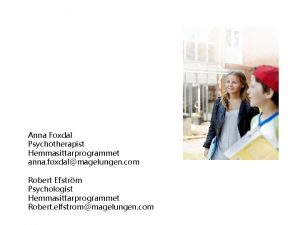Anna Strattan 2014 Components of Critique Sorrya critique


























- Slides: 26

Anna Strattan 2014 Components of Critique

Sorry…a critique is an ESSAY. The Essential Steps of Art Criticism 1. 2. 3. 4. Description (includes intro paragraph) Analysis Interpretation Judgment

When you remember the four steps, think of these questions…. 1. 2. 3. 4. Description Analysis Interpretation Judgment - What do I see? - How is the work organized? - What message does this artwork communicate (interpret)? - Is this a successful work of art?

Part I Description Introduction/Inventory • The introduction, includes information about the artwork that you are going to describe such as *credit line information – artist, title, date created, etc. • The “Description” should include the following information: – Subjects/characters - Items described must include things that are essential for interpretation! FACTS ONLY!!! – Inventory of items seen in the work. Items described must include things that are essential for interpretation! FACTS ONLY!!! NOTE: This is NOT the paragraph to talk about Elements and Principles

A critique is an ESSAY. Introduction/Inventory Make the first sentence count, and grab the reader’s attention. Ex. This critique will discuss the (type of art – painting/sculpture/print, etc. ) entitled, (insert title), (insert Artist ). The (medium/media) painting was created in (date it was created) and measures (insert measurements – if applicable). This piece can be classified as (abstract, realistic or non-objective) because the elements are (explain how you determined its classification) Note: Abstract – exaggerated from life Non-objective – focus on only formal elements (elements and principles of design) Realistic- idea and technique from life

Introduction Faith Ringgold. The Sunflower Quilting Bee at Arles. 1991 Acrylic on canvas, tie-dyed, pieced fabric border 74 x 80" Ex. This critique will discuss the painting entitled, The Sunflower Quilting Bee at Arles, by artist, Faith Ringgold. The mixed media painting was created in 1991 and measures 74 x 80 inches. This piece can be classified as Abstract because the elements are exaggerated from a life-like situation.

Description Ex. Surrounded by the flowers, eight African American women line the middleground, holding the edges of an outspread quilt pieced with more sunflowers. To the side and slightly behind them in a field of sunflowers, Van Gogh stands quietly in the background, holding a vase of his beloved sunflowers. The buildings of the village are shown in the background, painted with the bright hues.

Faith Ringgold. The Sunflower Quilting Bee at Arles. 1991 Acrylic on canvas, tie-dyed, pieced fabric border 74 x 80"

Part II Analysis THE ELEMENTS AND PRINCIPLES OF DESIGN -Ask yourself…. What (elements) stand out …. Color. Shapes. Forms. lines. Texture. Light and shadow. (value. ) -Then answer and how was it used …(the principles) Balance *Contrast * Emphasis/ focal pt * Movement* Pattern *

Analysis EX. Color is the main element in this painting by Faith Ringgold. The sunflowers' colors stick out with their yellow, brown, and black. The houses in the back of the scene are painted unique colors like red, pink, yellow, and green. The border is a mixture of reds, blues, whites, and blacks. Ringgold uses a complementary color scheme where bold reds standout against the green trees and background of the quilt. The circles are repeated in the sunflowers and faces on the women creating pattern and unity. The flowers circular shape contrasts the line and geometry of the building in the background.

Part III Interpretation FIRST - Determine the most important parts of the painting that tell the meaning or artist’s story…. should relate to ‘Description’ 1. 2. 3. 4. 5. Size of piece Quilt Ladies Van gogh Sunflowers Adapted from http: //voscreativearts. blogspot. com/

Interpretation Ex. There are African-American women all gather around a quilt, working on it together. All the women seem to be from different eras in history, perhaps they are famous and the meeting at the quilting bee. The women are pictured as quilters in order to piece together a better world, perhaps suggesting the value of collaboration versus the lone individual, standing in the background, Van Gogh contributes to the meaning of the piece in that there are many sunflowers in the background of the painting, and Vincent Van Gogh is well known for his sunflower paintings. The rich saturated hues is reminiscent of Van Gogh’s use of color.

Part IV Judgment Was the artwork successful? Use ideas and information in previous parts of the critique and State whether the composition and technique are successful or not and why. Mention if the art is an example of imitationalism, formalism or emotionalism and why. Note: Artwork can only fall under one aesthetic theory. Imitationalism Emotionalism Formalism

Let’s review the Aesthetic Theories

Judgment Imitationalism. Was the focus of the artwork for your critique realism? ? ? An imitationalist artwork is judged as good if it accomplishes this to a high degree. If the primary purpose of the artwork is to show us how something looks in real life, then it belongs in this category. (Imitational artworks are sometimes referred to as "representational" because they represent what we see in the real world. ) Examples of how to defend Imitationalism in your critique: • Imitationalism applies to areas in the artwork that look realistic/representational, such as…. • This painting contains recognizable, realistic looking objects and scenes that closely imitate what we see in the real world. (Write about what you claim is real about it) • The primary purpose of imitationalist art is to portray the subject matter as realistically as possible. In this painting…. NOTE: Portraits often fall into this category.

Judgment Ex. This painting by Chuck Close represents Imitationalism. This art is a type of art called photorealism. It is so realistic looking that many people mistake it for a photograph. Ex. This painting of a candy store also shows a high degree of imitationalism in that the storefront looks as if it were a photo.

Judgment Emotionalism. Does the artwork focus on the meaning, or mood, or message? ? ? Many artworks depict characters showing emotions. However, an artwork would not usually be classified as emotionalist unless the emotion being expressed was the primary purpose of the artwork…. and YOU understand the message well enough you can explain it! Examples of how to defend Emotionalism in your critique: • Emotionalism applies to this painting as the parts (list them) stress expressive qualities (explain the qualities). • The primary purpose of an emotionalist artwork is to vividly communicate moods, feelings and ideas to the viewer. This piece communicates…. (explain the connection to the images to the moods/feelings/ideas) • The main point of the artwork is to get the viewer's attention in a dramatic way and to impact the viewer's emotions. (Explain how the artist did this) NOTE: A good emotionalist artwork will succeed in getting the artist's message across.

Judgment Example: This artwork by David Siqueiros is an emotionalist piece designed to draw your attention to the horrors of war. A screaming baby's head emerges from the destruction. The artist is making the point that no child could survive in that environment for very long.

Judgment Formalism Formalist artworks can be both abstract and non-objective • The aesthetic theory known as formalism stresses the visual qualities of an artwork. • The focus is on the effective arrangements of lines, colors, shapes and other elements of art. • They are not intended to look realistic. Talk about its degree of abstrction. NOTE: A good formalist artwork is considered to be successful if the artist has created a visually interesting design or composition using the Elements and Principles of Design

Judgment Ex. Faith Ringold’s work is a successful formalist work of art. The artwork exhibits bold and contrasting shapes and colors effectively arranged which commands the viewer’s attention and imagination. She used abstraction in symbolic ways such as the position of the characters and interactions between them in the location depicted in the painting. The pained collage of carefully arranged geometric and natural shapes on a quilt beautifully expresses and renders Ringgold’s story about the interaction of special places and special people.

Putting it alllllll together. • What’s worse than writing a critique? Reading 10 of the same essays on the same artwork! • Write it to stand out! Write it to make it a bit more interesting! • EDIT, read aloud, peer/parent edit! Make sure it makes sense in grammar and conten Tip: Hone your ideas, your voice and make it flow! Questions to ask

IDEAS Are you focusing on SIGNIFICANT parts of the artwork? Are you taking a fresh perspective toward the artwork? Are you focusing on important details that go beyond the obvious?

Voice Does your writing express your enthusiasm and excitement about the artwork in question? Does the style of writing keep the audience in mind? Does YOUR personality come through in the writing? *** always read over your writing before you hand it in!***

Organization Does your writing follow a logical sequence of ideas? Do you have a lead that captures the reader’s interest? Has EVERYTHING you written clearly support your main ideas?


Review: • Where do you look for additional information that would be valuable to include in your Description portion of your Critique? • When you are writing your analysis, what are you are explaining? • When writing your interpretation , how do you connect the meaning to the artwork? • What are three aesthetic theories that you must between to relate to the artwork you are critiquing? • What is imitationalism? • What is the primary purpose of an imitationalist artwork? • What is formalism? • What is the primary purpose of formalism? • What is emotionalism? • What is the primary purpose of emotionalism? • Would all artworks that show emotions be classified as emotionalist?
 Key principles of action research
Key principles of action research Critique of planned change
Critique of planned change Nih critique template
Nih critique template Elc video critique
Elc video critique Whats a summary?
Whats a summary? Critique of feifer assessment of reading
Critique of feifer assessment of reading Art critique questions
Art critique questions Comparison and critique of osi and tcp/ip model
Comparison and critique of osi and tcp/ip model Kant third critique
Kant third critique Splunk incident management
Splunk incident management Compte rendu introduction
Compte rendu introduction Social criticism
Social criticism Bernard williams a critique of utilitarianism
Bernard williams a critique of utilitarianism Capm critique
Capm critique Art interpretation examples
Art interpretation examples Art critiquing process
Art critiquing process What is a critique?
What is a critique? What is culture industry
What is culture industry Authorial reticence
Authorial reticence Video critique plc
Video critique plc Comparison and critique of osi and tcp/ip model
Comparison and critique of osi and tcp/ip model Analysis sentence starters
Analysis sentence starters Example of painting critique
Example of painting critique Power threat meaning framework critique
Power threat meaning framework critique 4 step critique process
4 step critique process William frankena ethics summary
William frankena ethics summary Four steps in art criticism
Four steps in art criticism

